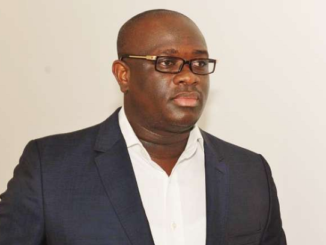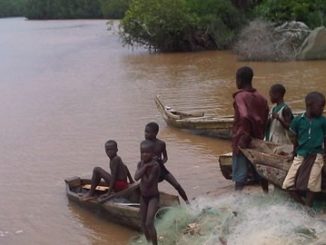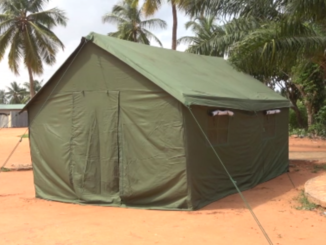The people of Alavanyo and Nkonya have entered the 10th month without any major incident. The volatile enclave has enjoyed relative peace largely because the youth from both sides of the divide are visibly tired of what some describe as a senseless conflict and have vowed that never again will they become guns for anybody to advance their selfish gains.
Since august last year, after the last gun was short, some well meaning natives of both traditional areas – Alavanyo and Nkonya – met and decided that they have had enough, their selfless collaboration and the resolve of many of the youth is responsible for the relative peace being enjoyed in the area.
For the first time the people have taken over the peace process, the team is not appointed by government they have not been put in place by any chief nor are they supported by any NGO, these are well meaning people, some who have been friends for years from both sides, desirous of seeing an end to the repeated episodes of killing and counter killing coming together to use the goodwill and trust amongst them to work for lasting peace. Their efforts without any iota of doubt are paying off big time and they have succeeded in building bridges and bringing the two communities together with renewed resolve to end the bloodshed once and for all. This home grown strategy appears to be the best thing that has happened the people of Alavanyo and Nkonya so far us the quest for peace in the area is concerned.
MODUS OPERANDI:
The conflict over the last few years was fought based on rumors and false alarms. Out of the blue, someone sends falls alarm that somebody has been killed in one of the areas; within seconds with the use of mobile phones, the news goes viral, warriors from the other side gang up and head towards the woods, they lay ambush and the first innocent person from the opponent side they see pays with his or her life.
Having identified this as a major cause, the committee made up of prominent people, assemblymen and some traditional rulers have established an early warning system on both sides, and their duty is to call people from the other side once the rumors come in to ascertain the veracity or other wise of the rumors, they then use the same social media to counter the rumors and warn of consequences should anybody take the laws into their own hands.
They have also consulted widely all stake holders in the conflict and threatened to disown, name and shame anybody who commits murder in the name of the conflict, they have promised to go a step further to hand such deviants to the authorities for prosecution and that the whole community will not be responsible for the actions of a few trigger happy youth who take delight in arbitrary murder in the name of a feud and “BIG MEN” who have become dogs of war.
The committee is also engaging the chiefs and opinion leaders from both sides separately to encourage them to forgive and forget, and mend fences. These consultations have made some serious revelations which the committee is working on as means to build trust as a precursor to a lasting peace in the area.
To demonstrate their commitment and desire for a lasting peace, 8 young men aged between 15 and 21 from Alavanyo about a few weeks ago embarked on a peace journey to Nkonya. They walked unarmed from Alavanyo Kpeme through Nkonya Tayi to Ahinkro. Their mission simply is that, they miss their old friends from Nkonya some they have not seen for years. “we have friends in Nkonya, very intimate friends we have not seen nor communicated with for years, we are tired, we want to see them shake hands with them and assure them that we are on the side of peace. They are our friend, we will not allow a senseless conflict deny us of our friendship” their leader told me.
Though they could not meet their paddies, their gallant move brought to the fore the urgent need for lasting peace to return to the area. Young people from Nkonya have indicated their resolve to reciprocate the visit; this they believe will further deepen the wind of change blowing and will encourage other such moves. Though permanent peace is some miles away, these efforts are opening the doors and the people are beginning to trust again.
BACKGROUND
The Volta Region of Ghana is made up of a multiplicity of tribes, though predominately Ewe speaking, the Ewe speakers who have varied dialects are the last to settle in the region. The Guans also make up of several dialects were the first to have settled in the region many years ago, these groups of people are believed to have migrated from Burkina Faso somewhere around AD 1000, fleeing from wars. They are inter alia, the people of Nkonya, Logba, Nyangbo, Tafi, Lolobi, Likpe, Santrokofi, Akposo, Buems, Adeles, Achodes, etc. We also have akans they are predominatly in the Kadjebi District and the worawora areas. They are believed to have also fled from wars in the present day Ashanti and eastern regions.
THE GUANS
The Guans are believed to have migrated from the Mossi region of modern Burkina Faso around A.D. 1000. Moving gradually through the Volta valley in a southwards, they settled along the Black Volta, throughout the Afram Plains, in the Volta Gorge, and in the Akwapim Hills before moving farther south onto the coastal plains. Some scholars postulate that the wide distribution of the Guan suggests that they were the Neolithic population of the region. Later migrations by other groups such as the Akan, Ewe, and Ga-Adangbe into Guan-settled areas would then have led to the development of Guan-speaking enclaves along the Volta and within the coastal plains.
A CHRONICLE OF EVENTS
The first violent incident erupted out of a dispute between two individual residents of Nkonya Tayi and Alavanyo Kpeme over a piece of land within the now disputed area. The attempt to resolve this conflict saw the various communities seeking assistance from the colonial authorities. Ultimately, it resulted in the designing of a map by a German Cartographer called Dr Hans Grunner assisted by Paul Sprigade in 1913 known as “Karte des Sechsherrens Tockes”, showing the boundaries of the six nation-states that surrounded the Togo Plateau – Nkonya, Alavanyo, Gbi, Santrokofi, Akpafu and Bowiri respectively. It is worthy of note at that In 1931, Norton Jones Esq. met representatives of the six nation-states on the issue of the Togo Plateau Forest Reserve Settlement Enquiry where they all agreed that their boundaries were as shown on the Gruner map drawn in 1913.
In May, 1923 nine elders from Nkonya-Tayi were reportedly brutally assaulted in Alavanyos when they went to Alavanyo Kpeme on a mission to discuss an observed encroachment on Nkonya land by eight Alavanyo farmers who were subsequently identified as Joseph Foli, Togbe Mensah Aniabor, Korkor Sampende, Trigautt Kosibu, W.A. Dornya, Kwasi Asigbetse, Eugene Prikutse and Aaron T. Kuma.
In 1953, Nkonya filed a suit at Akpini Court “B” seeking to evict the eight encroachers on Nkonya land, then in May, 1957 in the High Court, Accra, Justice Van Lare ruled in favour of Nkonya. Again in June, 1959 His Lordship, GRANVILLE SHARP J. A. Court of Appeal, up-held the accuracy and authenticity of the 1913 Gruner Map as indicating the true boundaries and that defendants (Alavanyo) are “estopped per rem judicatam” (a matter that has been finally determined), from ever raising the question about their boundaries; and that ”interest reipublicae ut sitifinis litium” (it is in the public interest that a litigation must come to an end). In December, 1970, High Court, Ho – Suit No. 28-35/61, 1970, Justice G. R. Mc Vane Francois ordered the Alavanyos to atone tenancy within one month of the ruling. In December, 1975, Court of Appeal, Accra Suit No. 112/74, Justice J. A. Amissah (Presiding), Kingsley Nyinah and J. A. Annan ruled in favour of Nkonya and up-held the 1970 ruling by Justice Francois. In December, 1980 Justice Mrs. Cecilia Koranteng-Addow quashed an order issued by the Stool Land Boundaries Commission for re-demarcation of the boundaries. She stated that, two previous rulings at the High Court and the Court of Appeal had up-held accuracy of the Dr. Gruner Map of 1913 and thus settled the issue of the boundaries.
Various governments have also formed several committees to find lasting solutions to the conflict but none of them was able to ensure lasting peace, if anything they only succeeded in deepening the already discordant seeds that had been sown between them. With the passage of time, the conflict has taken different shapes and tangents. While a number of the escalations have been triggered by land related issues, an outbreak in 1983 for example was largely out of a conflict between two individuals over the fetching of water. This quickly escalated into an Nkonya – Alavanyo affair with resultant loss of lives.
The conflict in recent times has taken a different dimension, it has become a cover for people to settle personal scores and for blood thirsty youth satisfy their thirst. Some schools of thought have also argued that, prominent people on both sides are fuelling the conflict for their parochial interest.
By: Gratham-Jaisey Mckintosh



